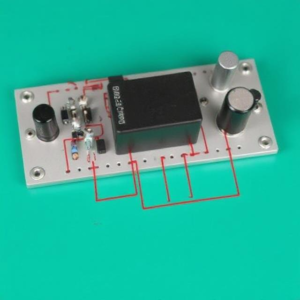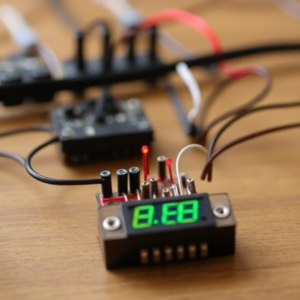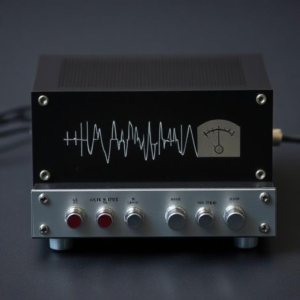What is a Comparator?
A comparator is an electronic circuit that compares two voltages or signals and tells us which one is higher or lower. It’s a type of op-amp (operational amplifier) used in this specific way.
- Input: A comparator takes in two input voltages, typically labeled as V₁ and V₂.
- Output: The output of a comparator is either high or low, depending on which input is larger.

How Does a Comparator Work?
- Two Inputs: A comparator has two inputs — non-inverting (+) and inverting (-). The voltage on these inputs is compared:
- Non-inverting input (+): This is the input that will “win” if it’s higher.
- Inverting input (-): This is the input that will “lose” if it’s higher.
- Comparison:
- If the voltage at the non-inverting input is greater than the voltage at the inverting input, the output of the comparator will go high (close to the power supply voltage).
- If the voltage at the inverting input is greater than the voltage at the non-inverting input, the output will go low (close to 0V or ground).
Output of the Comparator:
The output of a comparator is a digital signal (high or low), unlike an op-amp which has an analog output. So, the output “compares” the two input voltages and gives a clear yes/no answer:
- High output (logic 1) when V1>V2V_1 > V_2
- Low output (logic 0) when V1<V2V_1 < V_2
Simple Example:
Let’s say we have the following:
- V₁ = 5V (non-inverting input)
- V₂ = 3V (inverting input)
The comparator will compare these two voltages:
- Since V₁ > V₂, the output will go high (near the power supply voltage).
Now, if:
- V₁ = 2V (non-inverting input)
- V₂ = 3V (inverting input)
The output will go low (near 0V) because V₂ > V₁.
Applications of Comparator Circuits
Comparator circuits are used in a variety of applications. Here are some common ones:
- Zero Crossing Detector:
- A zero crossing detector is used to detect when a signal crosses zero voltage (from positive to negative or vice versa). This is useful in many digital circuits, especially for timing and synchronization.
Example: In an AC waveform, the comparator can detect when the signal crosses the zero line (0V) and generate a pulse at each crossing. This can be used to control timing in oscillators or convert AC signals to digital pulses.
- Pulse Width Modulation (PWM):
- In PWM, comparators are used to control the width of a pulse. For example, in a motor speed control system, the comparator compares a reference voltage with a varying input (like a sawtooth wave). The output controls how long the pulse is “on,” adjusting the speed of a motor.
- Window Comparator:
- A window comparator is used to detect if a signal is within a certain voltage range. It has two comparators: one compares the signal to an upper threshold, and the other compares it to a lower threshold. If the signal is within the window (between the two thresholds), the output is high; if outside, the output is low.
- Overvoltage and Undervoltage Detection:
- A comparator can be used to detect if a voltage exceeds a certain limit (overvoltage) or falls below a certain limit (undervoltage).
Example: In a power supply, comparators are used to monitor the output voltage. If the voltage goes too high or too low, the comparator can trigger an alarm or shut down the system to protect it.
- Schmitt Trigger:
- A Schmitt trigger is a special type of comparator with hysteresis. This means it has two different threshold voltages for switching the output on and off. This helps to clean up noisy signals, ensuring a clear output. It’s often used in digital circuits to turn noisy or fluctuating signals into clean logic signals (0 or 1).
Example: If you’re using a comparator to digitize a slowly changing analog signal (like a sine wave), the Schmitt trigger will help avoid multiple changes in the output due to noise or small variations in the input.
- Analog-to-Digital Conversion (ADC):
- Comparators are used in ADC circuits to convert an analog signal into a digital output. The comparator compares the input signal to a reference voltage and outputs a high or low signal, which is used to generate a binary output in the ADC process.
Advantages of Comparator Circuits:
- Fast Response: Comparators are usually very fast and can quickly change their output based on the comparison of input voltages.
- Low Cost: Comparators are inexpensive and simple to design, making them widely used in many electronic systems.
- Digital Output: Comparators give a clear, binary output (high or low), which is easy to interface with digital systems.
Summary:
- A comparator is an electronic circuit that compares two voltages and gives a high or low output based on which input voltage is higher.
- The output is a digital signal (high or low), not an analog one, which makes it useful for things like turning analog signals into digital signals or detecting thresholds.
- Applications of comparators include zero crossing detection, PWM, overvoltage protection, Schmitt triggers, and analog-to-digital conversion.
In simple terms, a comparator acts like a decision-maker that tells you which of two things is greater, and it can be used in many electronic devices to make quick, binary decisions based on voltage levels.











